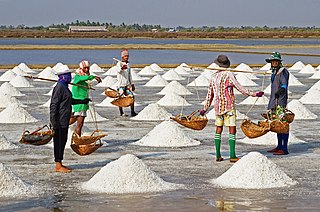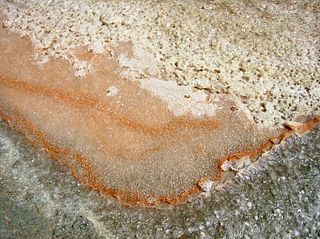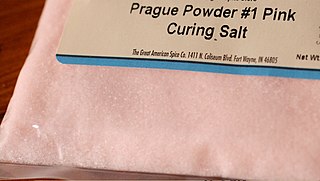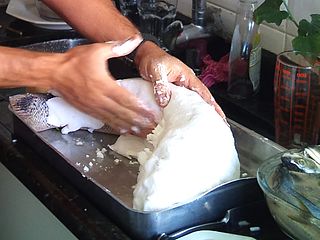
Tapioca is a starch extracted from the tubers of the cassava plant, a species native to the North and Northeast regions of Brazil, but whose use is now spread throughout South America. It is a perennial shrub adapted to the hot conditions of tropical lowlands. Cassava copes better with poor soils than many other food plants.

Sea salt is salt that is produced by the evaporation of seawater. It is used as a seasoning in foods, cooking, cosmetics and for preserving food. It is also called bay salt, solar salt, or simply salt. Like mined rock salt, production of sea salt has been dated to prehistoric times.

Halite, commonly known as rock salt, is a type of salt, the mineral (natural) form of sodium chloride (NaCl). Halite forms isometric crystals. The mineral is typically colorless or white, but may also be light blue, dark blue, purple, pink, red, orange, yellow or gray depending on inclusion of other materials, impurities, and structural or isotopic abnormalities in the crystals. It commonly occurs with other evaporite deposit minerals such as several of the sulfates, halides, and borates. The name halite is derived from the Ancient Greek word for "salt", ἅλς (háls).

Tamarin is a village on the western coast of Mauritius. It has long been the seat of the council district of Rivière Noire. The district council recently moved to its new headquarters in Bambous, this village being more accessible to the villagers.

Salmorejo, sometimes known as ardoria or ardorío, is a traditional creamy soup originating from Andalusia, southern Spain, made of pear tomato, bread, extra virgin olive oil and garlic. The salmorejo is served cold and may be garnished with diced Spanish ibérico ham and diced hard-boiled eggs.

In common usage, salt is a mineral composed primarily of sodium chloride (NaCl). When used in food, especially in granulated form, it is more formally called table salt. In the form of a natural crystalline mineral, salt is also known as rock salt or halite. Salt is essential for life in general, and saltiness is one of the basic human tastes. Salt is one of the oldest and most ubiquitous food seasonings, and is known to uniformly improve the taste perception of food, including otherwise unpalatable food. Salting, brining, and pickling are also ancient and important methods of food preservation.

Fleur de sel or flor de sal is a salt that forms as a thin, delicate crust on the surface of seawater as it evaporates. Fleur de sel has been collected since ancient times, and was traditionally used as a purgative and salve. It is now used as a finishing salt to flavor and garnish food. The origin of the name is uncertain, but is perfectly in line with both meanings of fleur:flower, and the surface of something. The salt crust forms flower-like patterns of crystals which may contribute to the name.

Curing salt is used in meat processing to generate a pinkish shade and to extend shelf life. It is both a color agent and a means to facilitate food preservation as it prevents or slows spoilage by bacteria or fungus. Curing salts are generally a mixture of sodium chloride and sodium nitrite, and are used for pickling meats as part of the process to make sausage or cured meat such as ham, bacon, pastrami, corned beef, etc. Though it has been suggested that the reason for using nitrite-containing curing salt is to prevent botulism, a 2018 study by the British Meat Producers Association determined that legally permitted levels of nitrite have no effect on the growth of the Clostridium botulinum bacteria that causes botulism, in line with the UK's Advisory Committee on the Microbiological Safety of Food opinion that nitrites are not required to prevent C. botulinum growth and extend shelf life..

A baking stone is a portable cooking surface used in baking. It may be made of ceramic, stone or, more recently, salt. Food is put on the stone, which is then placed in an oven, though sometimes the stone is heated first. Baking stones are used much like cookie sheets, but may absorb additional moisture for crispier food. A pizza stone is a baking stone designed for cooking pizza.

Steamed clams is a seafood dish consisting of clams cooked by steaming.

Alaea salt, alternatively referred to as Hawaiian red salt, is an unrefined sea salt that has been mixed with an iron oxide rich volcanic clay called ʻalaea, which gives the seasoning its characteristic brick red color. It is part of Native Hawaiian cuisine and is used in traditional dishes such as kalua pig, poke, and pipikaula. It was also traditionally used to cleanse, purify and bless tools, canoes, homes and temples. Once exported to the Pacific Northwest to cure salmon, it saw a resurgence in popularity late in the 20th century in fusion style cuisine of Hawaii both on Islands and beyond.
La Presqu’île de Guérande is an Atlantic destination located in the North-West of France, between the Loire estuary and the mouth of the Vilaine. It encompasses about 20 towns split up into two departments: Morbihan and Loire-Atlantique. This area is often called Guérande Peninsula, partly because of Guérande, a scenic town that triggers off images of a medieval town and the salt marshes.

Mark Bitterman is an American entrepreneur and food writer. He is the owner of The Meadow, a boutique that specializes in finishing salts, bean-to-bar chocolate, cocktail bitters, and other products. The Meadow was founded in Portland, Oregon, in 2006, and has expanded to include three locations in Portland, one in Nolita in New York City, and one in Shinjuku, Tokyo. Bitterman began selling salt wholesale to award-winning restaurateurs in 2006, and in 2012 officially launched the Bitterman Salt Co. to sell salt through retailers nationally. Bitterman has published five books. Two are on traditional culinary salts and their use in cooking. Two are about cooking with Himalayan salt blocks, and helped pioneer the concept. His remaining book is on the use of bitters and amari in mixology and cooking. He consults with restaurateurs and lectures at culinary academies about the use of finishing salts and Himalayan salt blocks.

Salted: A Manifesto on the World's Most Essential Mineral, with Recipes is a reference book and cookbook written by food writer Mark Bitterman. In May 2011 Salted won the James Beard Foundation Award for Reference and Scholarship Cookbook. It has also been nominated for the International Association of Culinary Professionals Cookbook Awards for the Food & Beverage Reference/Technical category and First Book: The Julia Child Award. It is available both in hardcover and on the Kindle.
Flake salt refers to a category of salt characterized by their dry, plate-like ("lamellose") crystals. Their structure is a result of differing growth rates between the faces and edges of the crystal, an effect that can be achieved in various ways. Flake salt may occur naturally but can also be produced by a variety of methods, including boiling brine over metal salt pans or evaporating it in greenhouse solar evaporators. The technologies used as well as atmospheric conditions can yield varying crystal structures. Flake salts can form as irregular shavings, pyramidal shapes, boxes, or potato chip-like laminated crystals. These salts tend to have lower trace mineral content than other salts, giving them a stronger salty taste. Most form as thin, flattened out crystals with a large surface area and low mass that give them a crunchy texture and relatively fast dissolution rate. Because of the salts' delicate structures, selmeliers tend to use them as finishing salts.

Extrusion in food processing consists of forcing soft mixed ingredients through an opening in a perforated plate or die designed to produce the required shape. The extruded food is then cut to a specific size by blades. The machine which forces the mix through the die is an extruder, and the mix is known as the extrudate. The extruder is typically a large, rotating screw tightly fitting within a stationary barrel, at the end of which is the die.

A salt crust is a method of cooking by completely covering an ingredient such as fish, chicken or vegetables in salt before baking. The salt layer acts as insulation and helps cook the food in an even and gentle manner. After baking, the salt crust is cracked and discarded, revealing the moist and evenly cooked food.

Fried cauliflower is a popular dish in many cuisines of the Middle East, South Asia, Europe, and elsewhere. It may start from raw or cooked cauliflower; it may be dipped in batter or breading; it may be fried in oil, butter, or other fats. It can be served on its own, as a mezze or side dish, or in a sandwich. It is often seasoned with salt, spices, and a variety of sauces, in the Middle East often based on tahini or strained yogurt.

Maldon Crystal Salt Company Limited, trading as Maldon Salt, is a salt-producing company in Maldon on the high-salinity banks of the River Blackwater in Essex, England. The river is favoured by flat tide-washed salt marshes and low rainfall.

















